Econ 315: Labor Economics Assignment: Analyzing US Labor Market Data
VerifiedAdded on 2022/08/08
|10
|953
|13
Homework Assignment
AI Summary
This labor economics assignment analyzes the US labor market, focusing on employment and labor force data using FRED. The assignment examines the unemployment rate, employment levels, and labor force participation rates for both men and women from 1948 to 2020. It explores trends in total non-farm employment, comparing different sectors like construction, retail trade, and financial activities. The analysis also includes retail sales data, trends in full-time and part-time employment, and manufacturing industry employment. The assignment utilizes data from various sources, including the Current Population Survey and the Establishment Survey, and presents findings with supporting graphs and references. The study reveals significant shifts in employment patterns, such as the rise in retail trade and the decline in manufacturing, and discusses factors influencing labor force participation. The analysis highlights the importance of employment as a key indicator of economic health.
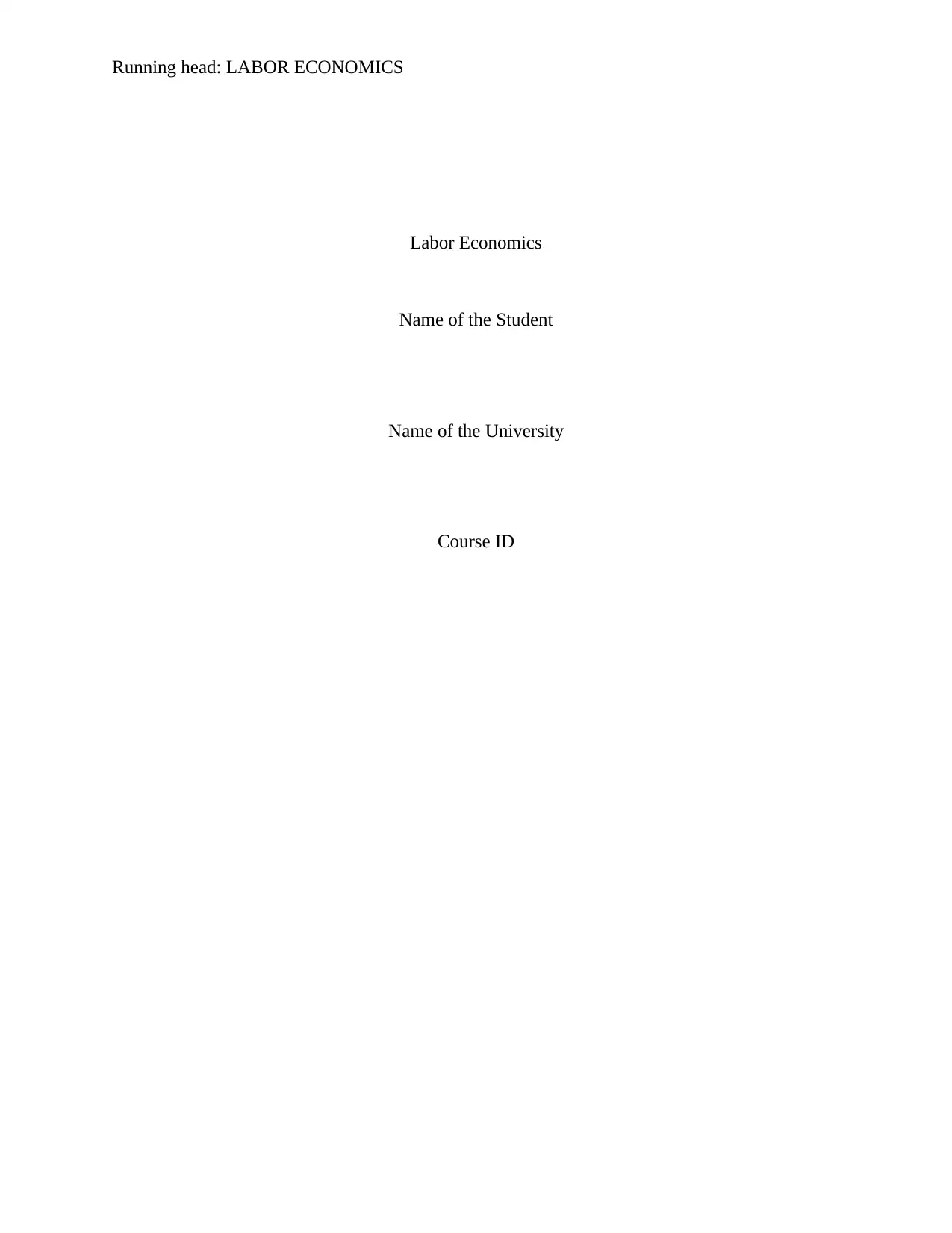
Running head: LABOR ECONOMICS
Labor Economics
Name of the Student
Name of the University
Course ID
Labor Economics
Name of the Student
Name of the University
Course ID
Paraphrase This Document
Need a fresh take? Get an instant paraphrase of this document with our AI Paraphraser
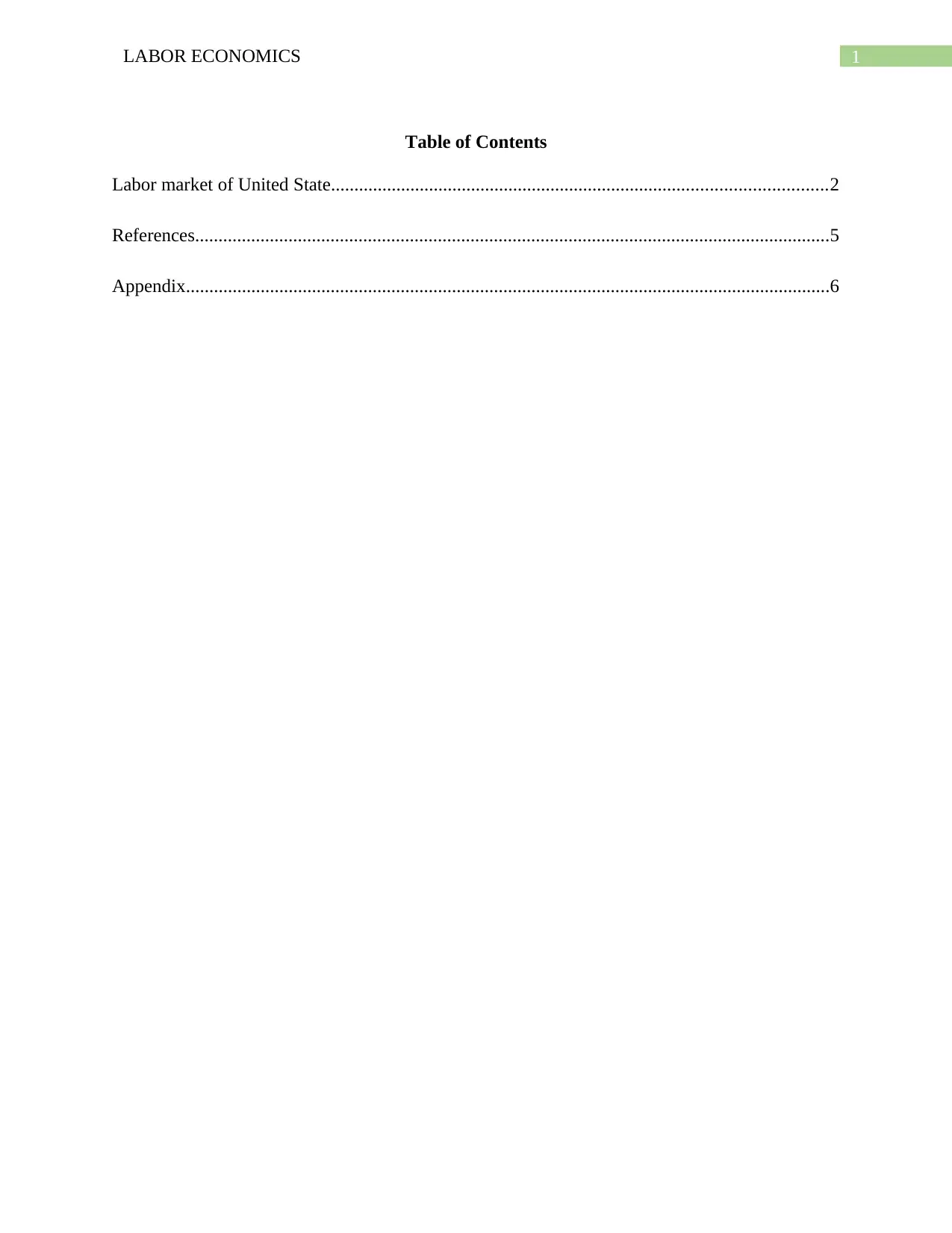
1LABOR ECONOMICS
Table of Contents
Labor market of United State..........................................................................................................2
References........................................................................................................................................5
Appendix..........................................................................................................................................6
Table of Contents
Labor market of United State..........................................................................................................2
References........................................................................................................................................5
Appendix..........................................................................................................................................6
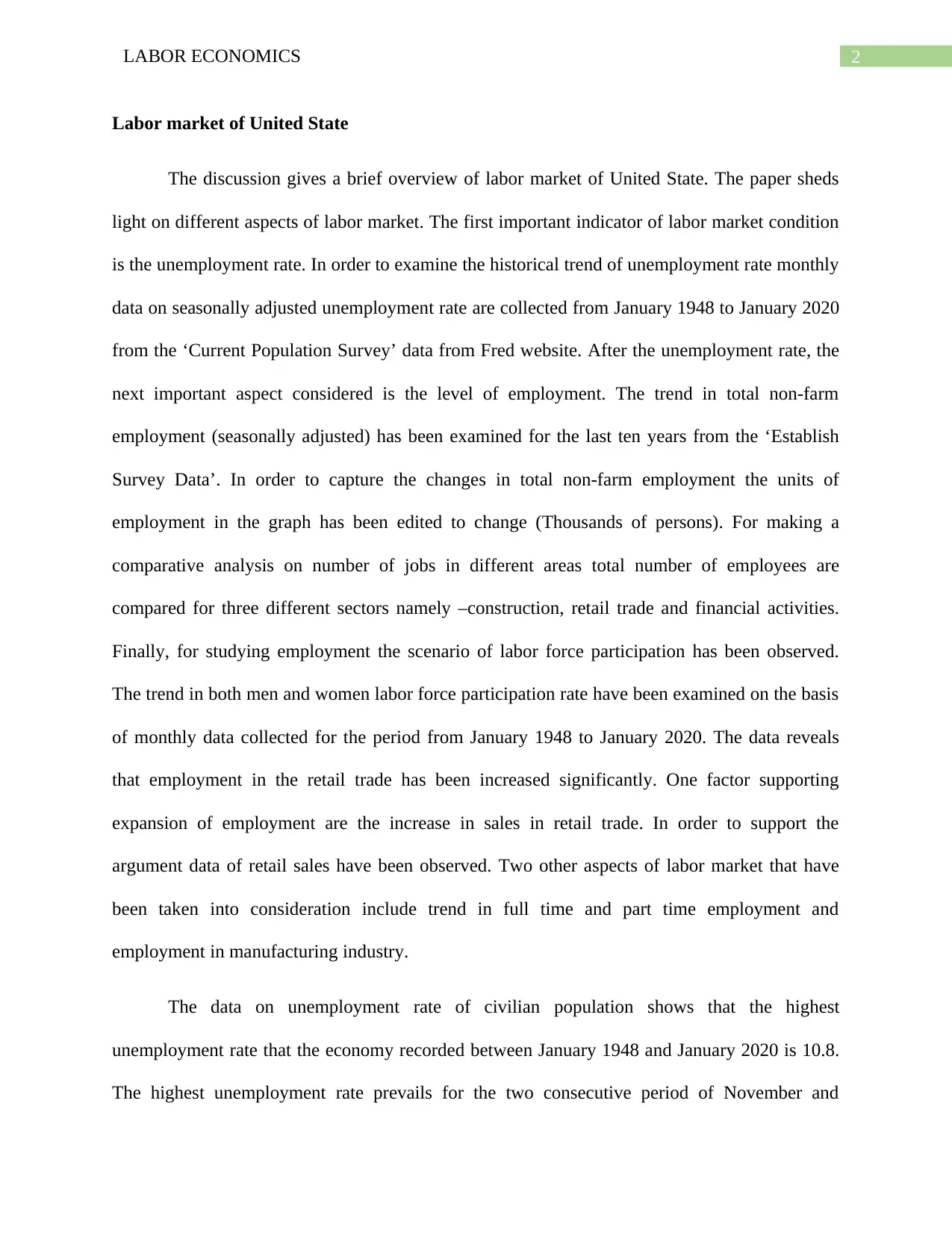
2LABOR ECONOMICS
Labor market of United State
The discussion gives a brief overview of labor market of United State. The paper sheds
light on different aspects of labor market. The first important indicator of labor market condition
is the unemployment rate. In order to examine the historical trend of unemployment rate monthly
data on seasonally adjusted unemployment rate are collected from January 1948 to January 2020
from the ‘Current Population Survey’ data from Fred website. After the unemployment rate, the
next important aspect considered is the level of employment. The trend in total non-farm
employment (seasonally adjusted) has been examined for the last ten years from the ‘Establish
Survey Data’. In order to capture the changes in total non-farm employment the units of
employment in the graph has been edited to change (Thousands of persons). For making a
comparative analysis on number of jobs in different areas total number of employees are
compared for three different sectors namely –construction, retail trade and financial activities.
Finally, for studying employment the scenario of labor force participation has been observed.
The trend in both men and women labor force participation rate have been examined on the basis
of monthly data collected for the period from January 1948 to January 2020. The data reveals
that employment in the retail trade has been increased significantly. One factor supporting
expansion of employment are the increase in sales in retail trade. In order to support the
argument data of retail sales have been observed. Two other aspects of labor market that have
been taken into consideration include trend in full time and part time employment and
employment in manufacturing industry.
The data on unemployment rate of civilian population shows that the highest
unemployment rate that the economy recorded between January 1948 and January 2020 is 10.8.
The highest unemployment rate prevails for the two consecutive period of November and
Labor market of United State
The discussion gives a brief overview of labor market of United State. The paper sheds
light on different aspects of labor market. The first important indicator of labor market condition
is the unemployment rate. In order to examine the historical trend of unemployment rate monthly
data on seasonally adjusted unemployment rate are collected from January 1948 to January 2020
from the ‘Current Population Survey’ data from Fred website. After the unemployment rate, the
next important aspect considered is the level of employment. The trend in total non-farm
employment (seasonally adjusted) has been examined for the last ten years from the ‘Establish
Survey Data’. In order to capture the changes in total non-farm employment the units of
employment in the graph has been edited to change (Thousands of persons). For making a
comparative analysis on number of jobs in different areas total number of employees are
compared for three different sectors namely –construction, retail trade and financial activities.
Finally, for studying employment the scenario of labor force participation has been observed.
The trend in both men and women labor force participation rate have been examined on the basis
of monthly data collected for the period from January 1948 to January 2020. The data reveals
that employment in the retail trade has been increased significantly. One factor supporting
expansion of employment are the increase in sales in retail trade. In order to support the
argument data of retail sales have been observed. Two other aspects of labor market that have
been taken into consideration include trend in full time and part time employment and
employment in manufacturing industry.
The data on unemployment rate of civilian population shows that the highest
unemployment rate that the economy recorded between January 1948 and January 2020 is 10.8.
The highest unemployment rate prevails for the two consecutive period of November and
⊘ This is a preview!⊘
Do you want full access?
Subscribe today to unlock all pages.

Trusted by 1+ million students worldwide
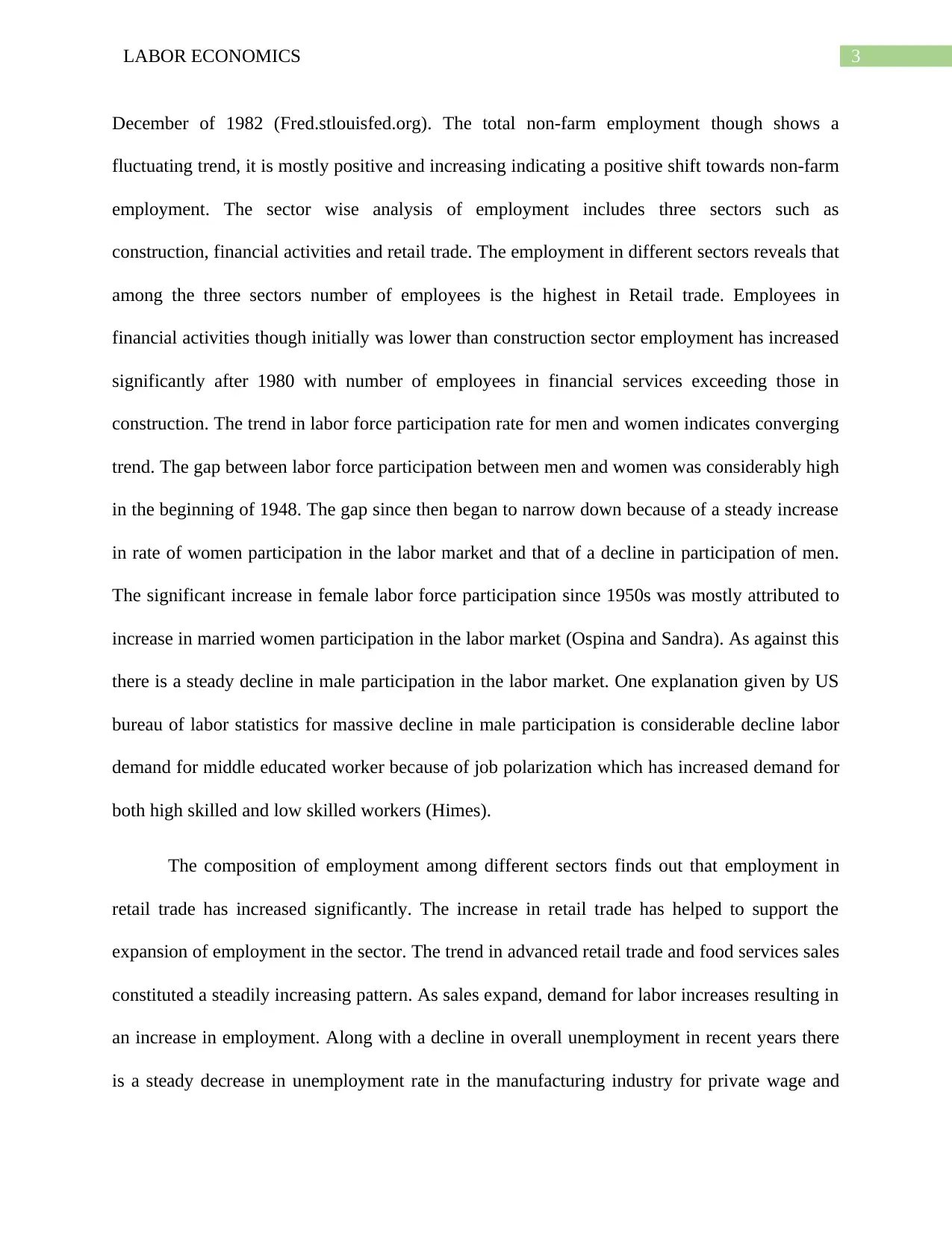
3LABOR ECONOMICS
December of 1982 (Fred.stlouisfed.org). The total non-farm employment though shows a
fluctuating trend, it is mostly positive and increasing indicating a positive shift towards non-farm
employment. The sector wise analysis of employment includes three sectors such as
construction, financial activities and retail trade. The employment in different sectors reveals that
among the three sectors number of employees is the highest in Retail trade. Employees in
financial activities though initially was lower than construction sector employment has increased
significantly after 1980 with number of employees in financial services exceeding those in
construction. The trend in labor force participation rate for men and women indicates converging
trend. The gap between labor force participation between men and women was considerably high
in the beginning of 1948. The gap since then began to narrow down because of a steady increase
in rate of women participation in the labor market and that of a decline in participation of men.
The significant increase in female labor force participation since 1950s was mostly attributed to
increase in married women participation in the labor market (Ospina and Sandra). As against this
there is a steady decline in male participation in the labor market. One explanation given by US
bureau of labor statistics for massive decline in male participation is considerable decline labor
demand for middle educated worker because of job polarization which has increased demand for
both high skilled and low skilled workers (Himes).
The composition of employment among different sectors finds out that employment in
retail trade has increased significantly. The increase in retail trade has helped to support the
expansion of employment in the sector. The trend in advanced retail trade and food services sales
constituted a steadily increasing pattern. As sales expand, demand for labor increases resulting in
an increase in employment. Along with a decline in overall unemployment in recent years there
is a steady decrease in unemployment rate in the manufacturing industry for private wage and
December of 1982 (Fred.stlouisfed.org). The total non-farm employment though shows a
fluctuating trend, it is mostly positive and increasing indicating a positive shift towards non-farm
employment. The sector wise analysis of employment includes three sectors such as
construction, financial activities and retail trade. The employment in different sectors reveals that
among the three sectors number of employees is the highest in Retail trade. Employees in
financial activities though initially was lower than construction sector employment has increased
significantly after 1980 with number of employees in financial services exceeding those in
construction. The trend in labor force participation rate for men and women indicates converging
trend. The gap between labor force participation between men and women was considerably high
in the beginning of 1948. The gap since then began to narrow down because of a steady increase
in rate of women participation in the labor market and that of a decline in participation of men.
The significant increase in female labor force participation since 1950s was mostly attributed to
increase in married women participation in the labor market (Ospina and Sandra). As against this
there is a steady decline in male participation in the labor market. One explanation given by US
bureau of labor statistics for massive decline in male participation is considerable decline labor
demand for middle educated worker because of job polarization which has increased demand for
both high skilled and low skilled workers (Himes).
The composition of employment among different sectors finds out that employment in
retail trade has increased significantly. The increase in retail trade has helped to support the
expansion of employment in the sector. The trend in advanced retail trade and food services sales
constituted a steadily increasing pattern. As sales expand, demand for labor increases resulting in
an increase in employment. Along with a decline in overall unemployment in recent years there
is a steady decrease in unemployment rate in the manufacturing industry for private wage and
Paraphrase This Document
Need a fresh take? Get an instant paraphrase of this document with our AI Paraphraser
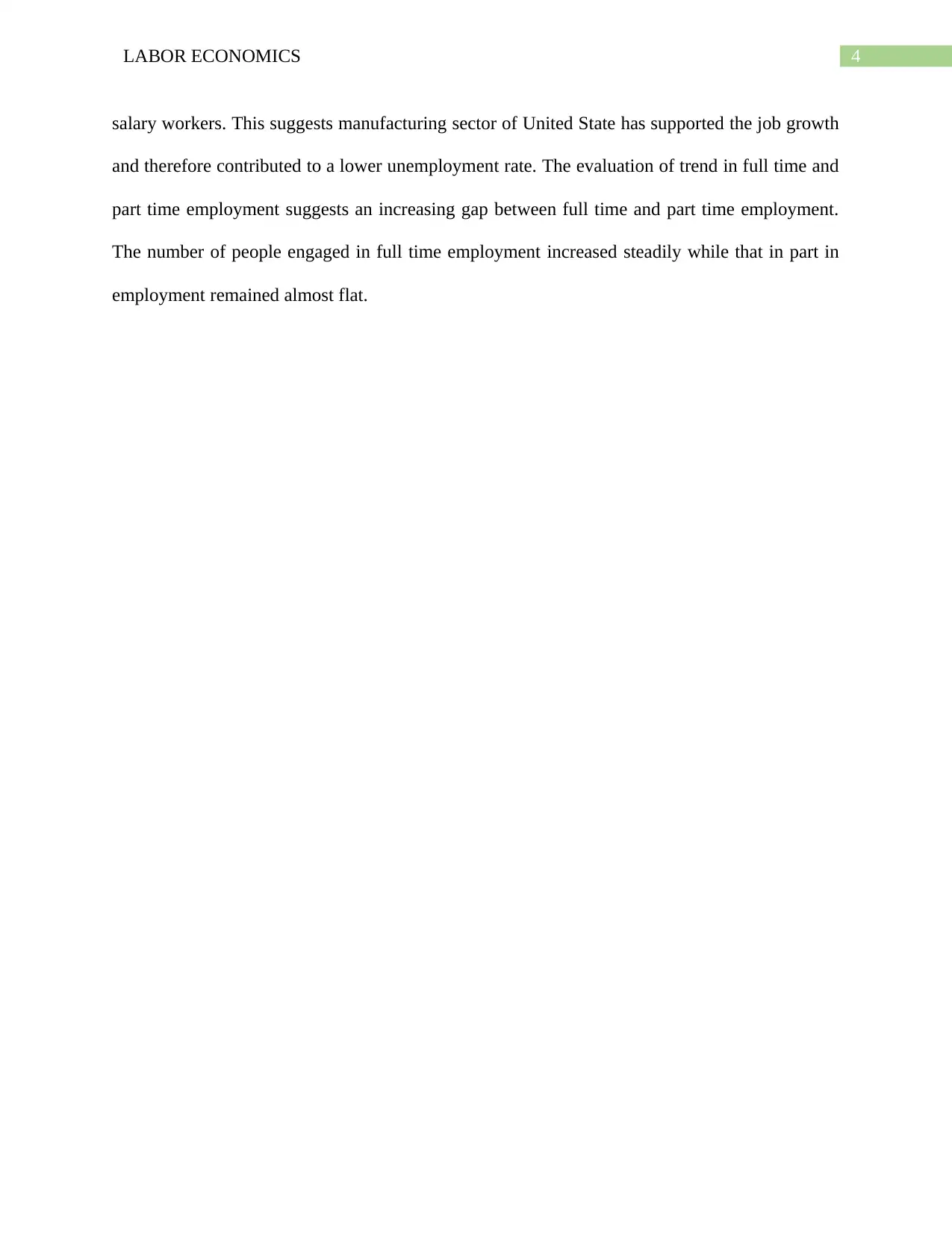
4LABOR ECONOMICS
salary workers. This suggests manufacturing sector of United State has supported the job growth
and therefore contributed to a lower unemployment rate. The evaluation of trend in full time and
part time employment suggests an increasing gap between full time and part time employment.
The number of people engaged in full time employment increased steadily while that in part in
employment remained almost flat.
salary workers. This suggests manufacturing sector of United State has supported the job growth
and therefore contributed to a lower unemployment rate. The evaluation of trend in full time and
part time employment suggests an increasing gap between full time and part time employment.
The number of people engaged in full time employment increased steadily while that in part in
employment remained almost flat.
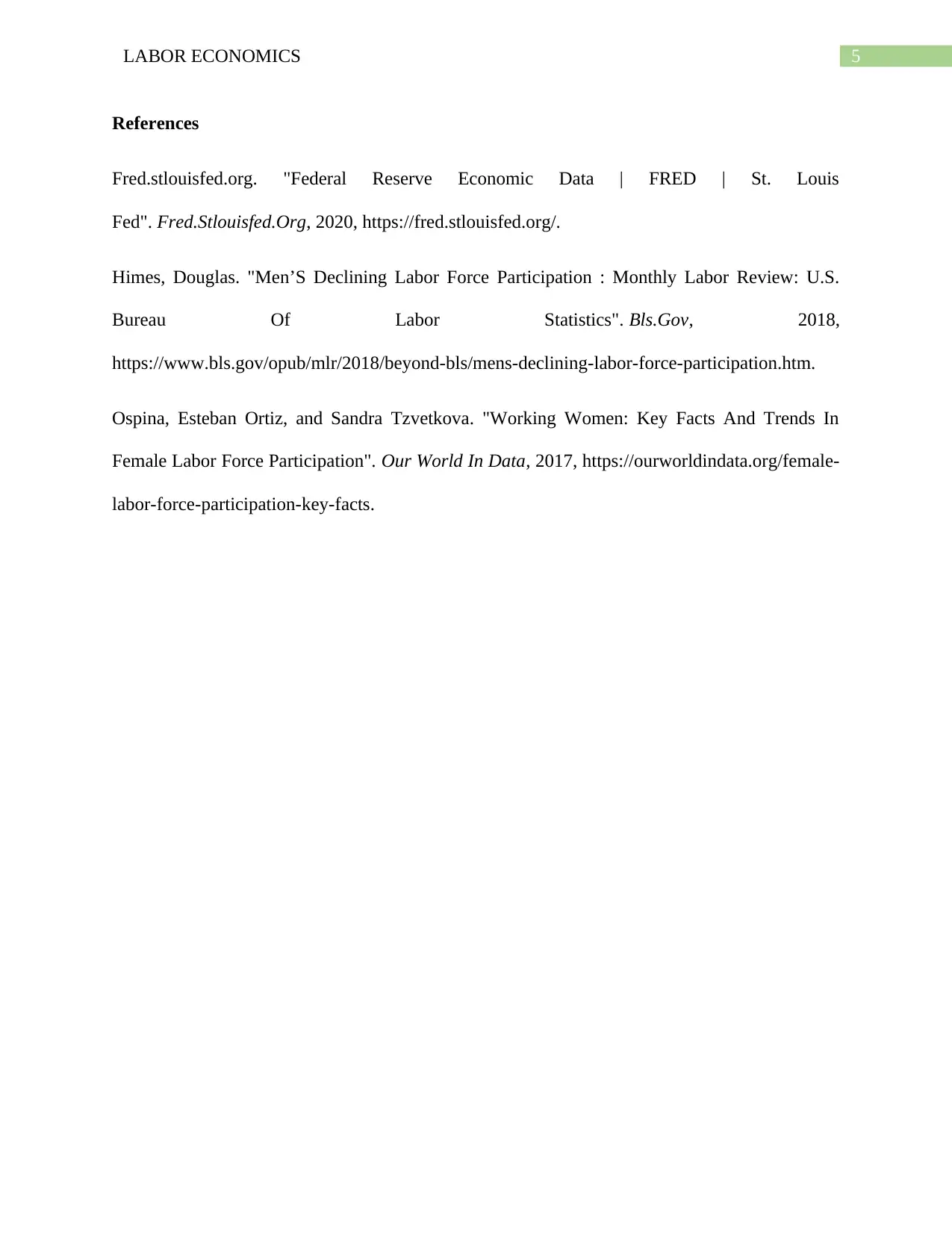
5LABOR ECONOMICS
References
Fred.stlouisfed.org. "Federal Reserve Economic Data | FRED | St. Louis
Fed". Fred.Stlouisfed.Org, 2020, https://fred.stlouisfed.org/.
Himes, Douglas. "Men’S Declining Labor Force Participation : Monthly Labor Review: U.S.
Bureau Of Labor Statistics". Bls.Gov, 2018,
https://www.bls.gov/opub/mlr/2018/beyond-bls/mens-declining-labor-force-participation.htm.
Ospina, Esteban Ortiz, and Sandra Tzvetkova. "Working Women: Key Facts And Trends In
Female Labor Force Participation". Our World In Data, 2017, https://ourworldindata.org/female-
labor-force-participation-key-facts.
References
Fred.stlouisfed.org. "Federal Reserve Economic Data | FRED | St. Louis
Fed". Fred.Stlouisfed.Org, 2020, https://fred.stlouisfed.org/.
Himes, Douglas. "Men’S Declining Labor Force Participation : Monthly Labor Review: U.S.
Bureau Of Labor Statistics". Bls.Gov, 2018,
https://www.bls.gov/opub/mlr/2018/beyond-bls/mens-declining-labor-force-participation.htm.
Ospina, Esteban Ortiz, and Sandra Tzvetkova. "Working Women: Key Facts And Trends In
Female Labor Force Participation". Our World In Data, 2017, https://ourworldindata.org/female-
labor-force-participation-key-facts.
⊘ This is a preview!⊘
Do you want full access?
Subscribe today to unlock all pages.

Trusted by 1+ million students worldwide
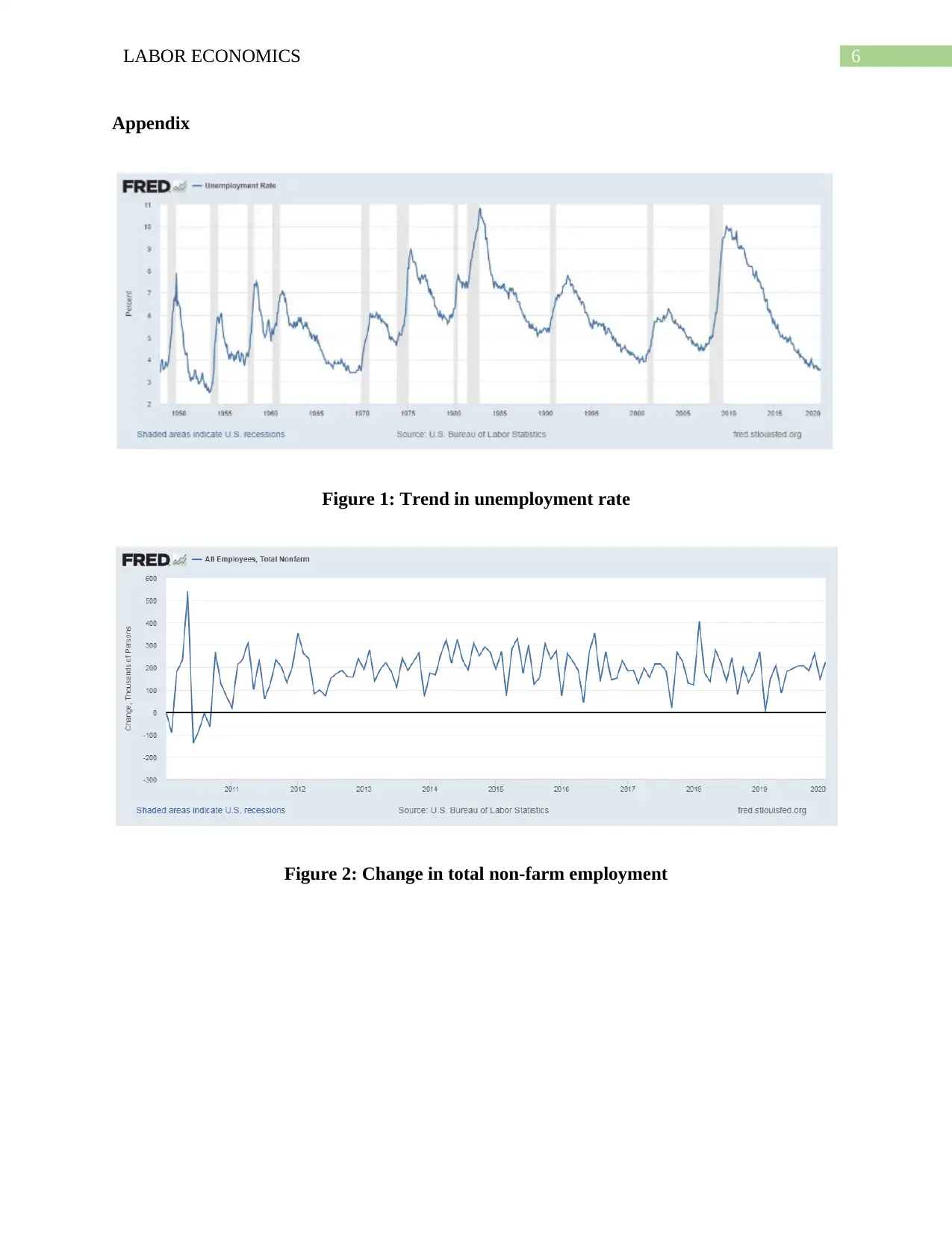
6LABOR ECONOMICS
Appendix
Figure 1: Trend in unemployment rate
Figure 2: Change in total non-farm employment
Appendix
Figure 1: Trend in unemployment rate
Figure 2: Change in total non-farm employment
Paraphrase This Document
Need a fresh take? Get an instant paraphrase of this document with our AI Paraphraser
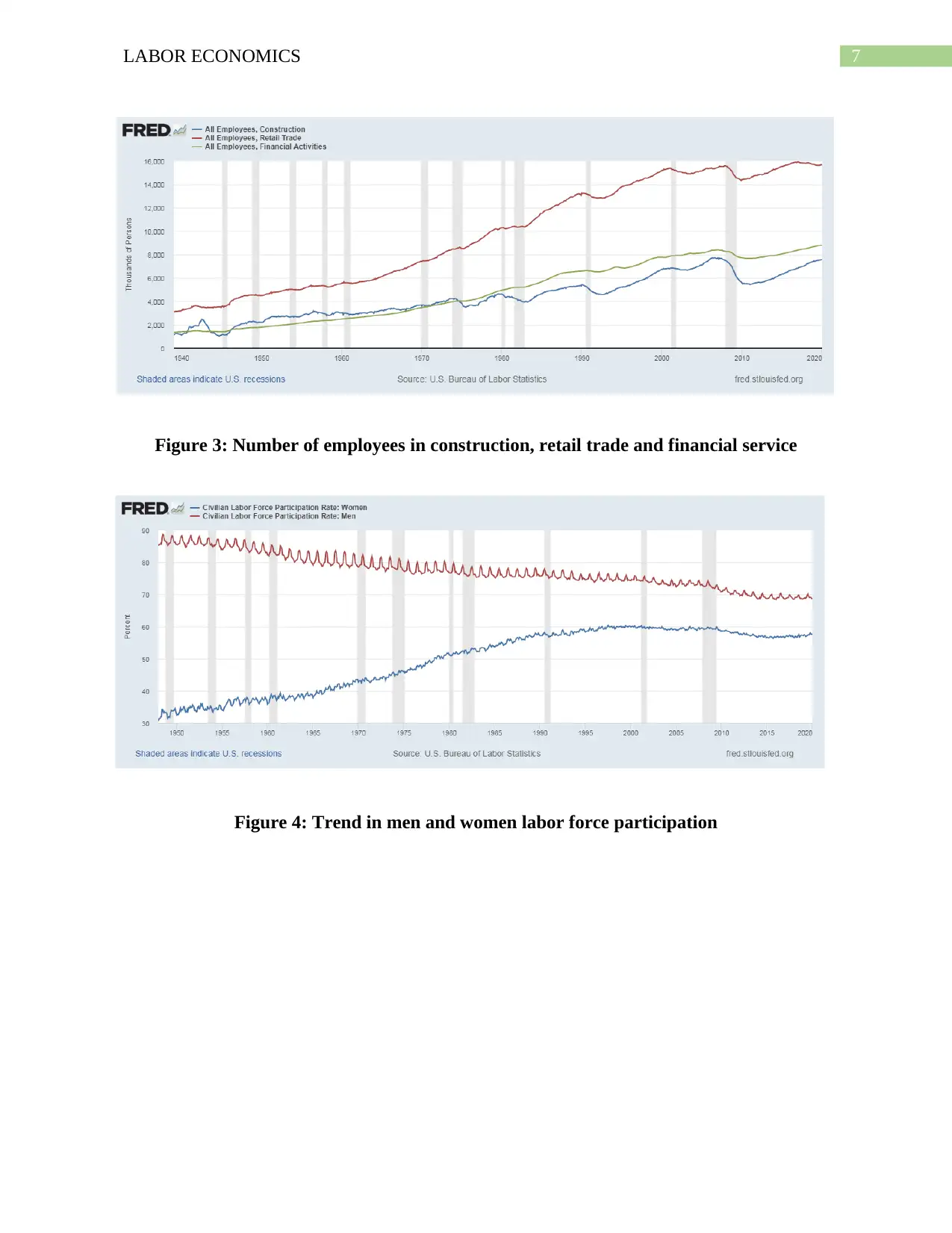
7LABOR ECONOMICS
Figure 3: Number of employees in construction, retail trade and financial service
Figure 4: Trend in men and women labor force participation
Figure 3: Number of employees in construction, retail trade and financial service
Figure 4: Trend in men and women labor force participation
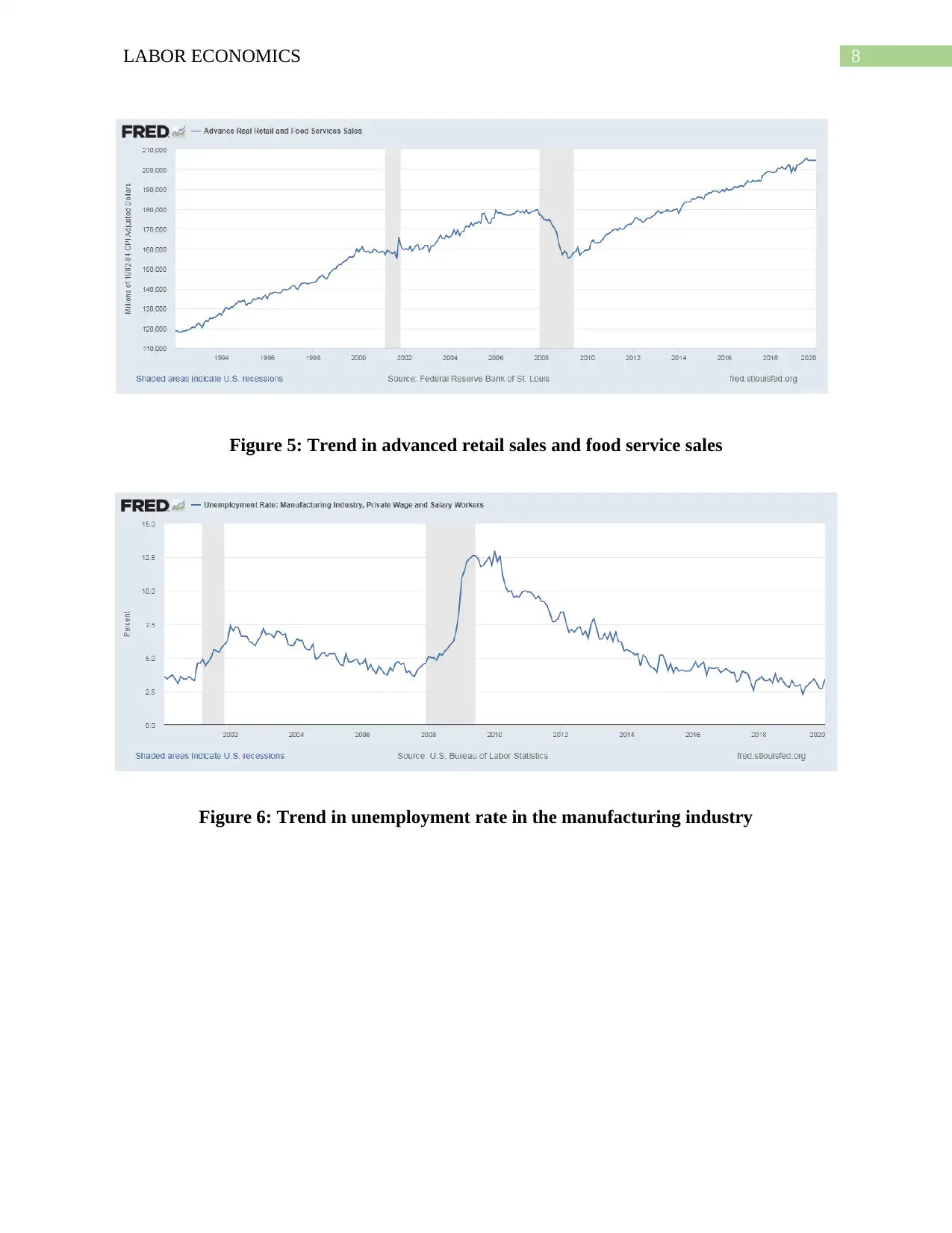
8LABOR ECONOMICS
Figure 5: Trend in advanced retail sales and food service sales
Figure 6: Trend in unemployment rate in the manufacturing industry
Figure 5: Trend in advanced retail sales and food service sales
Figure 6: Trend in unemployment rate in the manufacturing industry
⊘ This is a preview!⊘
Do you want full access?
Subscribe today to unlock all pages.

Trusted by 1+ million students worldwide
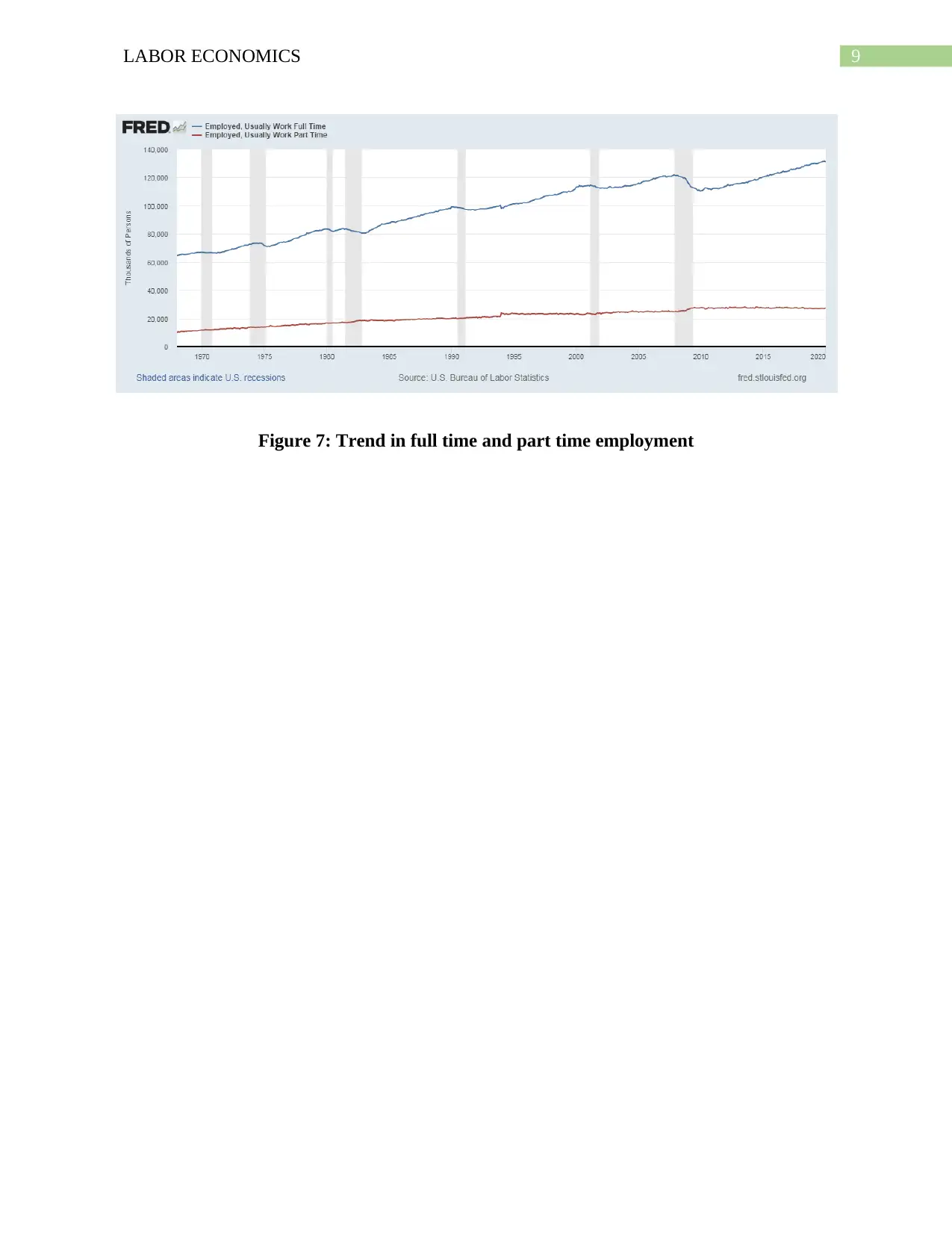
9LABOR ECONOMICS
Figure 7: Trend in full time and part time employment
Figure 7: Trend in full time and part time employment
1 out of 10
Related Documents
Your All-in-One AI-Powered Toolkit for Academic Success.
+13062052269
info@desklib.com
Available 24*7 on WhatsApp / Email
![[object Object]](/_next/static/media/star-bottom.7253800d.svg)
Unlock your academic potential
Copyright © 2020–2025 A2Z Services. All Rights Reserved. Developed and managed by ZUCOL.





